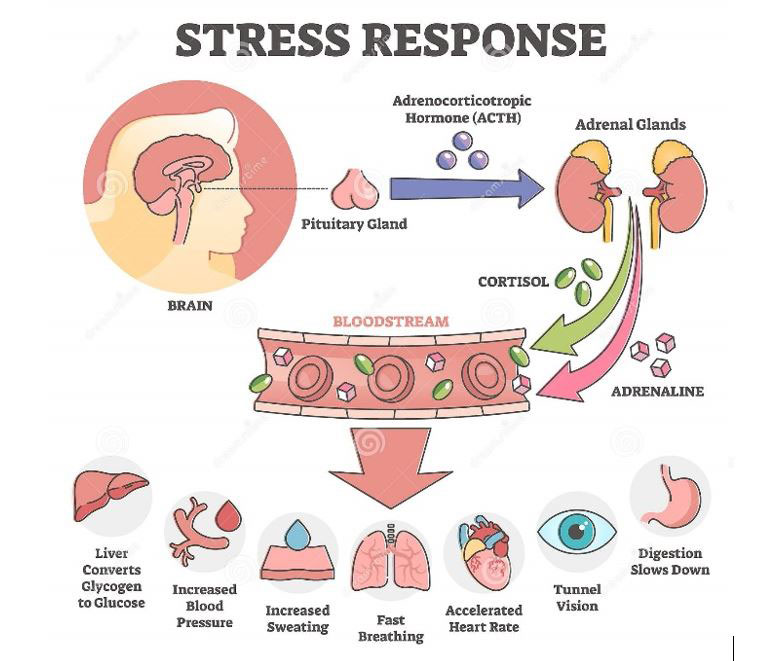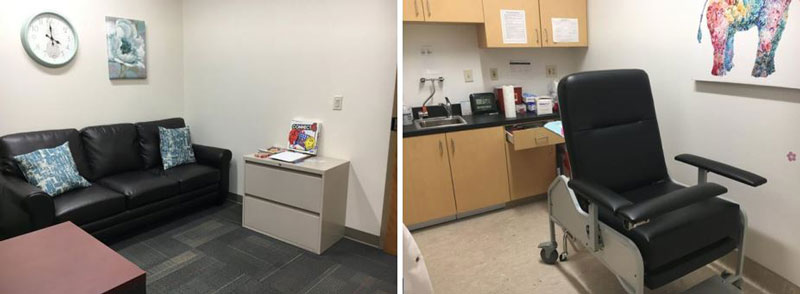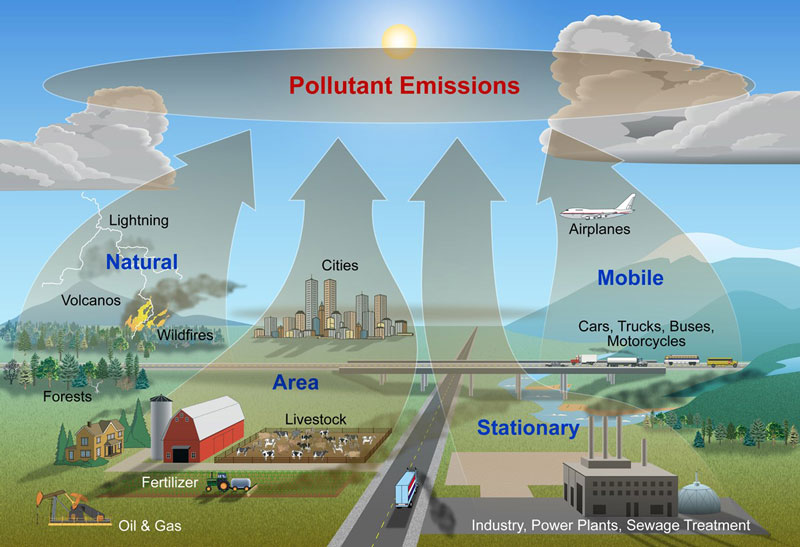Highlights
These researchers aim to understand how supportive relationships, such as those between parents or guardians and their children, reduce stress and improve health outcomes. This study brought children and a parent or guardian into the laboratory to investigate the physiological impacts of parental relationships in children undergoing stress.
Three groups were studied: parent-supported, children alone, and control groups. The results showed that participants in both the parent-supported and alone groups had increased cortisol levels and increased stress compared with the control group. When investigated further, the researchers found that differences between groups may depend on the type of support the parent or guardian provides.
While conducting this study, wildfires were raging in California. This motivated the researchers to conduct a parallel study to assess changes in physiological markers in study participants at baseline based on air pollution levels. They found that increased levels of air pollution were related to higher levels of inflammation in the blood.
According to the American Psychological Association (APA), a growing number of children and adolescents are experiencing mental health challenges. Between 2016 and 2019, research by the
U.S. Department of Health and Human Services
reported a rise in the number of children and adolescents ages 3-17 diagnosed with
anxiety
(29% increase) and
depression
(27% increase). Since the COVID-19 pandemic,
researchers
estimate the number of youth with anxiety and depression has doubled. The APA suggests numerous factors for this decline in mental health among young people in the U.S., including increased social isolation and family tension due to the pandemic, global political instability, and school shootings, among others.
During moments of stress or uncertainty, children and adolescents may turn to trusted adults in their lives such as parents, guardians, or other family members, to help manage their feelings. New research by Dr. Camelia Hostinar, Anna Parenteau, and colleagues at the University of California, Davis (UC Davis) sought to better understand how parents and guardians can support their children to manage stressful situations.
Dr. Hostinar runs the Social Environment and Stress (SES) laboratory at UC Davis, where her research focuses on how the life experiences of young people impact their stress response and overall health. You can think of stress as a change in the environment that must be responded to. When you are under stress, you might notice that you start to breathe more quickly or that your heart starts to beat more rapidly.
This happens because stress triggers a physiological response in our bodies. One result of the stress response is the release of
cortisol.
Cortisol regulates our blood pressure and many other functions in the body. This can be good when the stress only lasts for a short period of time, like before a big test or deadline. However, if the stress is ongoing, it can lead to poor health in the future.

Figure 1. In response to stress, our bodies release the hormone adrenocorticotropic hormone (ACTH) from the pituitary gland which, in turn, stimulates the adrenal glands to release the hormones cortisol and adrenaline, causing the body’s response to these hormones.
[Source: https://www.dreamstime.com/stress-response-anatomical-scheme-body-inner-reaction-outline-concept-stress-response-anatomical-scheme-body-inner-image210572681]
One role of parents and guardians in our lives is to help us learn to navigate stressful situations and feelings that might come up so that stress does not become chronic. Dr. Hostinar wants to understand how supportive relationships, such as those between parents or guardians and their children, can help reduce stress and improve health outcomes. Support received from relationships that reduce the stress response is known as
social buffering.
Social Buffering and Stress
In a recent study, Dr. Hostinar and colleagues brought children and a parent or guardian into the laboratory to investigate the physiological impacts of parental relationships in children undergoing stress.

Figure 2. Images of the Social Environment and Stress (SES) Laboratory at the University of California, Davis.
[Source: https://seslab.ucdavis.edu/]
The study included 180 children between the ages of 9-11 years and a parent or guardian. Prior to coming into the laboratory, research assistants had an initial phone call with the parent or guardian to determine eligibility. In addition, the parent or guardian reported demographic information including the sex and race of their child, annual household income, and the parent’s highest level of education.
Child participants and their parent or guardian came to the SES lab for a single visit. Research assistants explained to both the child and parent or guardian about the study and received their consent to participate before proceeding.
Participants were randomly assigned to three groups to determine the potential impacts of the presence of a parent or guardian on the child’s stress response. The three groups were evenly divided into a parent-supported condition (59 participants), an alone condition (60 participants) and a control condition (61 participants).
Children assigned to the parent-supported and alone conditions (119 participants total) completed a commonly used laboratory stress task called the Trier Social Stress Test (TSST). The TSST was originally designed for adults and included a presentation and math test conducted in front of panelists who were directed not to provide feedback or encouragement. In the version of the TSST adapted for children (the TSST-M), participants were told they have 10 minutes to develop a short presentation that would be recorded and evaluated by a panel of judges. The topic of the presentation was introducing themselves to a new classroom of students. After the 10-minute preparation time, participants were taken to a new room where the video camera was turned on and a panel of two judges in white lab coats listened to the presentation. Next, the participants were asked to do a five-minute math task. The judges remained neutral during the entire task, not providing any feedback or encouragement.
The experience of those in the parent-supported and alone conditions differed in the parental support the child received during the 10-minute preparation period. In the parent-supported condition, the child had their parent or guardian present during the preparation time. Parents or guardians were instructed to support their children with the following prompt: “Please feel free to provide support to your child in any way you find useful. Anything from helping with ideas for the speech to hugs is alright, so long as it is what feels natural for you.” This preparation period was video recorded for the researchers to analyze later. After the 10-minute preparation time with the parent or guardian, the child was taken to a new room by themselves to undergo the stressful situation described above.
In the alone condition, the parent or guardian was escorted out of the room and the child was given 10 minutes to prepare for the stressful task by themselves. After the 10 minutes, they were taken by themselves to a new room, just like the children in the parent-supported condition.
In the control condition, participants were given a different task that would require similar speaking and math demands but without the elements of evaluation because there was no recording or judges present. Participants were asked to spend 10 minutes with their parent or guardian thinking about their favorite book or movie and jotting down some notes about its plot. After 10 minutes, the child was taken alone to a new room where they had a friendly conversation about their chosen book or movie. For the math challenge, participants were asked to play a
sudoku
game for five minutes. If the participants were not familiar with the game, it was explained to them, and they were given access to hints and answers. During the time the participant was working on the sudoku puzzle, the research assistant was cleaning the room so the participant would not feel watched or judged.
Throughout the study visit, researchers took physiological measurements of the participants in all three groups. Saliva samples were taken 10 minutes after arriving at the laboratory and every 20 minutes after that for a total of eight saliva samples. Two blood samples were taken, one 30 minutes after arrival and one after the final saliva sample. In addition, the researchers used a validated tool to measure participant anxiety levels 30 minutes following the TSST-M.
Results
After the study was complete, it was time for Dr. Hostinar, Anna, and colleagues to analyze their data. All saliva samples were analyzed for levels of cortisol, a hormone that is an indicator of stress. In particular, the researchers were looking for changes in cortisol levels as a result of the stressful event.
The results showed all participants who had completed the TSST-M (the parent-supported and alone groups) had increased cortisol levels and increased stress compared with the control group. This was an expected result. The researchers were surprised that there was no significant difference between the parent-supported and alone groups, so they decided to look further into the data. After examining different variables, the researchers found that the education level of the parent or guardian was related to the cortisol levels in children.
The researchers divided parent or guardian education level into two groups: those with a four-year degree or higher and those with less than a four-year degree. The cortisol levels in children whose parent or guardian had less than a four-year college degree looked more like the children in the control group and were less than those in the alone group. However, children in the parent-supported condition whose parent or guardian had a four-year degree or higher experienced higher levels of cortisol compared to both the alone group and the control.
“We hypothesize that these differences might be related to the type of support parents are providing,” explained Anna. For example, previous studies have shown that parents with higher education levels may emphasize their child’s performance over comfort, which could increase the child’s anxiety levels. More research is needed to better understand these results. For example, it is possible that the social buffering effect of having a parent or guardian present is stronger after the stressful event compared to beforehand. It is also possible that parental buffering effects are stronger in certain kinds of stressful events and less so in others. Another important factor is that some children may find different types of support more or less helpful, so even though parents try their best to support their child, it may not be the type of support the child needs during a stressful challenge. The researchers plan to address these and other questions in future work.
An Additional Study: Air Pollution and Health
At the same time that participants and their parents or guardians were coming to the SES lab for this study (2017-2019), wildfires were raging across northern California. At UC Davis, where this study was taking place, university classes were canceled in 2018 because smoke from the nearby Camp Fire became too severe.

Figure 3. Image of air quality before (right) and during (left) the Camp Fire in 2018.
[Source: https://commons.wikimedia.org/wiki/File:2018_campfire_smoke_effects_on_San_Francisco.jpg]
This led Dr. Hostinar and her team to wonder how poor air quality due to fires, and air pollution more generally, was affecting the health of children. Since the research study described above was ongoing, Dr. Hostinar and colleagues decided to conduct a parallel study that assessed changes in physiological markers in study participants at baseline based on air pollution levels.
Air pollution is an important environmental factor that has known impacts on human health and wellbeing. What A Year! has highlighted several researchers studying the effects of air pollution on health. For example, research
by Dr. Cole Brokamp and colleagues at Cincinnati Children’s Hospital found that elevated levels of air pollution increased the risk of
acute psychiatric episodes
in children and adolescents. Research by Dr. Tom Russ and colleagues at the Alzheimer Scotland Dementia Research Centre and Centre for Clinical Brain Sciences at the University of Edinburgh, Scotland showed that lifetime pollution exposure can lead to cognitive decline in older age. Additional
research
has shown that exposure to air pollution can increase health problems such as
asthma,
particularly in children.
There are many sources of air pollution that cause these adverse health effects including vehicle emissions, power plants, industrial facilities, and agricultural activity.

Figure 4. Common sources of air pollution including vehicle emissions, power plants, industrial facilities, and wildfires.
[Source: https://www.nps.gov/subjects/air/sources.htm]
An increasingly common source of air pollution comes from wildfires. Due to climate change, the wildfire season is becoming longer with stronger fires, causing even more air pollution each year. Previous research has shown that air pollution can cause increased levels of inflammation in the body.
The researchers used the baseline blood samples they had already collected from participants in the ongoing stress study to test for several markers of inflammation. They connected levels of inflammation to air pollution levels on the day and month the blood sample was taken. The results showed that increased levels of air pollution were related to higher levels of inflammation in the blood. This result aligns with previous studies. While the researchers cannot definitively say that the increased air pollution levels they saw were a result of the ongoing wildfires, they did notice heightened levels of air pollution during the wildfire months.
Future Work
In future studies, Anna and Dr. Hostinar plan to expand their research into the social buffering of stress and the health impacts of air pollution in children. To do this, they are currently conducting a larger study of children aged 11-15 years old. These children will also complete a test of their stress response, and the baseline measures will be analyzed for markers of inflammation related to air pollution.
Anna Parenteau is a doctoral candidate in the lab of Dr. Hostinar. Her research focuses on the parent-child relationship, environmental influences on the stress response, and how parents can work with their children to best support them. When not in the laboratory, Anna enjoys biking, baking, and spending time with friends.
Dr. Hostinar is an Associate Professor of Psychology at the University of California, Davis in Davis, California where she runs the Social Environment and Stress Lab. Her research focuses on how the social environment affects stress and immune responses in children and adolescents. When not in the laboratory, Dr. Hostinar enjoys spending time in nature and doing arts and crafts projects with her children.
For More Information:
- Parenteau, A. et al. 2022. “Associations of air pollution with peripheral inflammation and cardiac autonomic physiology in children.” New Directions for Child and Adolescent Development, 181-182:125-154. https://onlinelibrary.wiley.com/doi/10.1002/cad.20474
- Parenteau, A. et al. 2020. “Parenting matters: Parents can reduce or amplify children's anxiety and cortisol responses to acute stress.” Developmental Psychopathology, 32(5): 1799-1809. https://www.ncbi.nlm.nih.gov/pmc/articles/PMC9306352/
- Hostinar, C. et al. 2014. “Psychobiological mechanisms underlying the social buffering of the hypothalamic-pituitary-adrenocortical axis: a review of animal models and human studies across development.”Psychological Bulletin, 140(1):256-82. https://pubmed.ncbi.nlm.nih.gov/23607429/
To Learn More:
Stress in Children and Adolescents
- Social Environment and Stress Lab, UC Davis. https://seslab.ucdavis.edu/
- KidsHealth. https://kidshealth.org/en/parents/stress.html
- American Psychological Society. https://www.apa.org/topics/children/stress
Wildfires, Air Pollution, and Children’s Health
- Centers for Disease Control and Prevention. https://www.cdc.gov/air/wildfire-smoke/children.htm
- U.S. Environmental Protection Agency. https://www.epa.gov/children/protecting-childrens-health-during-and-after-natural-disasters-wildfires-volcanic-ash
- Center for Climate, Health, and the Global Environment. https://www.hsph.harvard.edu/c-change/subtopics/wildfires-and-health/
Written by Rebecca Kranz with Andrea Gwosdow, PhD at www.gwosdow.com
HOME | ABOUT | ARCHIVES | TEACHERS | LINKS | CONTACT
All content on this site is © Massachusetts
Society for Medical Research or others. Please read our copyright
statement — it is important. |

